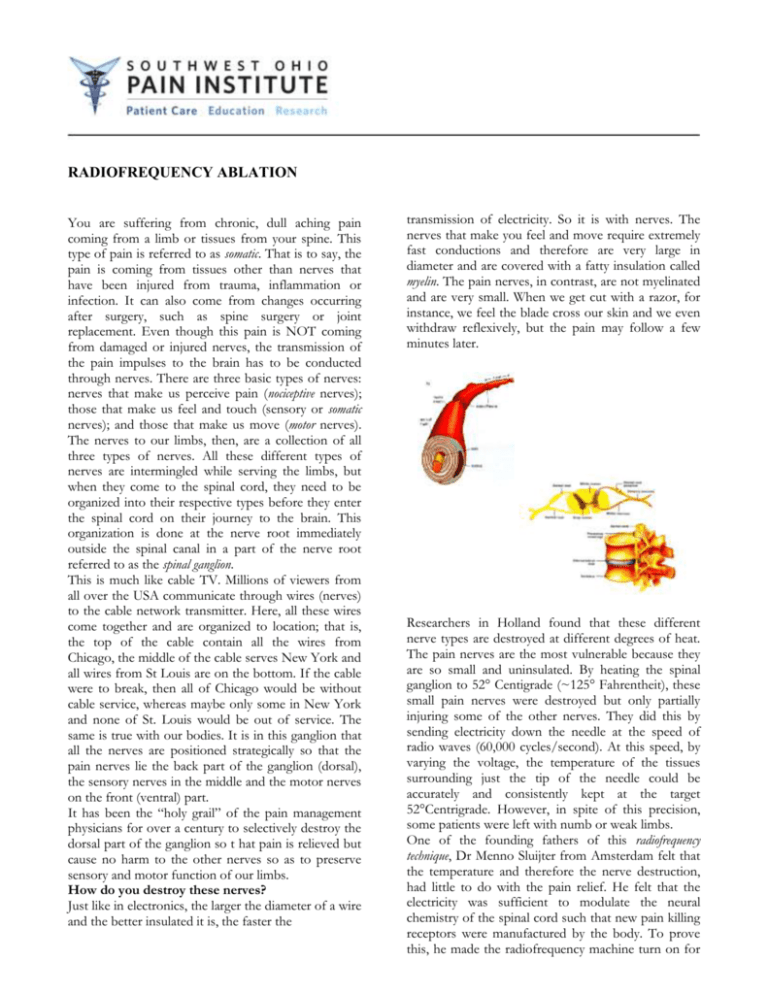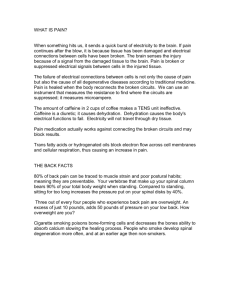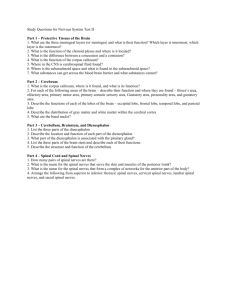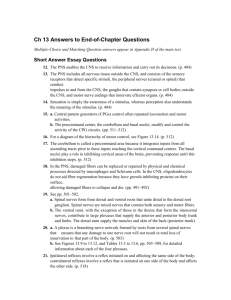Radiofrequency Ablation
advertisement

RADIOFREQUENCY ABLATION You are suffering from chronic, dull aching pain coming from a limb or tissues from your spine. This type of pain is referred to as somatic. That is to say, the pain is coming from tissues other than nerves that have been injured from trauma, inflammation or infection. It can also come from changes occurring after surgery, such as spine surgery or joint replacement. Even though this pain is NOT coming from damaged or injured nerves, the transmission of the pain impulses to the brain has to be conducted through nerves. There are three basic types of nerves: nerves that make us perceive pain (nociceptive nerves); those that make us feel and touch (sensory or somatic nerves); and those that make us move (motor nerves). The nerves to our limbs, then, are a collection of all three types of nerves. All these different types of nerves are intermingled while serving the limbs, but when they come to the spinal cord, they need to be organized into their respective types before they enter the spinal cord on their journey to the brain. This organization is done at the nerve root immediately outside the spinal canal in a part of the nerve root referred to as the spinal ganglion. This is much like cable TV. Millions of viewers from all over the USA communicate through wires (nerves) to the cable network transmitter. Here, all these wires come together and are organized to location; that is, the top of the cable contain all the wires from Chicago, the middle of the cable serves New York and all wires from St Louis are on the bottom. If the cable were to break, then all of Chicago would be without cable service, whereas maybe only some in New York and none of St. Louis would be out of service. The same is true with our bodies. It is in this ganglion that all the nerves are positioned strategically so that the pain nerves lie the back part of the ganglion (dorsal), the sensory nerves in the middle and the motor nerves on the front (ventral) part. It has been the “holy grail” of the pain management physicians for over a century to selectively destroy the dorsal part of the ganglion so t hat pain is relieved but cause no harm to the other nerves so as to preserve sensory and motor function of our limbs. How do you destroy these nerves? Just like in electronics, the larger the diameter of a wire and the better insulated it is, the faster the transmission of electricity. So it is with nerves. The nerves that make you feel and move require extremely fast conductions and therefore are very large in diameter and are covered with a fatty insulation called myelin. The pain nerves, in contrast, are not myelinated and are very small. When we get cut with a razor, for instance, we feel the blade cross our skin and we even withdraw reflexively, but the pain may follow a few minutes later. Researchers in Holland found that these different nerve types are destroyed at different degrees of heat. The pain nerves are the most vulnerable because they are so small and uninsulated. By heating the spinal ganglion to 52° Centigrade (~125° Fahrentheit), these small pain nerves were destroyed but only partially injuring some of the other nerves. They did this by sending electricity down the needle at the speed of radio waves (60,000 cycles/second). At this speed, by varying the voltage, the temperature of the tissues surrounding just the tip of the needle could be accurately and consistently kept at the target 52°Centrigrade. However, in spite of this precision, some patients were left with numb or weak limbs. One of the founding fathers of this radiofrequency technique, Dr Menno Sluijter from Amsterdam felt that the temperature and therefore the nerve destruction, had little to do with the pain relief. He felt that the electricity was sufficient to modulate the neural chemistry of the spinal cord such that new pain killing receptors were manufactured by the body. To prove this, he made the radiofrequency machine turn on for 0.2 seconds and then turn off for 0.8 seconds making How is the procedure performed? sure that the nerve never got hotter than normal. By The procedure is performed with the aid of a doing this, he gave the same dose of electricity but the fluoroscopy unit referred to as a Carm. With this xray spinal ganglion was NEVER injured – yet the patient device, the target foramen can be visualized which we received the same relief as if the gangion was know the nerve root is exiting. A very thin insulated destroyed! He referred to this adaptation as pulsed needle is then placed down the beam of the xray until radiofrequency technique. As no tissue is destoyed, he felt it enters the foramen. A small amount of xray dye is it was a much safer technique. injected to insure that the needle has reached the target tissue. At this time, the radiofrequency treatment is begun and lasts 4mnutes. It is painless. Afterward, you will be observed for 15-20minutes in a recovery area. What are the risks? Infection, bleeding and nerve damage are unlikely but possible risks of any spinal procedure. Since the needle is so close to the nerve root, injury to the nerve is unlikely, but possible. What are the side effects? Most common adverse event is failure to relieve pain even with successful ablation of nerves. There are very few side effects as there is nothing injected and the nerve is not injured. The typical bruising and muscle pain can occur from the needle insertion, but should pass in a day or so. It is important to point out that it might take 4-6 weeks before any relief is noticed after this technique. It is felt that this is the time necessary for the body to genetically manufacture these new pain killing receptors. Will there be any followup? A followup visit is scheduled in a month to evaluate the status of the pain and further disposition. ON THE DAY OF YOUR PROCEDURE PLEASE DO THE FOLLOWING: Take all blood pressure pills & heart medications prior to the procedure. Eat a light breakfast such as toast and coffee. Have a responsible person to drive you home. Arrive at requested procedure time. Please do not be late or your procedure may be moved to a later time or cancelled. ON THE DAY OF YOUR PROCEDURE, PLEASE DO THE FOLLOWING: ♦ Take all blood pressure pills & heart medications prior to the procedure with a sip of water at least 3 hours before your requested arrival time. Your vitals must be stable to have the procedure. ♦ Have a responsible person to take you home. ♦ Arrive at the requested procedure time. Please do not be late or your procedure may be cancelled. ON THE DAY OF YOUR PROCEDURE: ♦ Do not take ANY of the following 5 days before your procedure: Coumadin ♦Do not take ANY of the following 7 days before your procedure: Plavix ♦ Coumadin must be stopped prior to the injection. You must have a normal INR prior to the injection. Do not stop the drug by yourself. ♦ Eat or drink 6 hours before the procedure. NOTE: YOUR PROCEDURE WILL BE CANCELLED IF: - - You have an active infection, flu, cold, fever, or very high blood pressure. You do not have a responsible driver to take you home, arrive late for your procedure, or unable to follow the medication / fluid restrictions. Call the office at (513) 860-1039 for procedure related questions.







